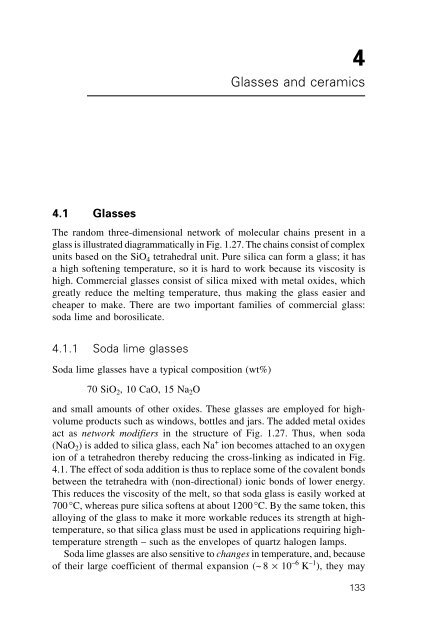Materials for engineering, 3rd Edition - (Malestrom)
Create successful ePaper yourself
Turn your PDF publications into a flip-book with our unique Google optimized e-Paper software.
4<br />
Glasses and ceramics<br />
4.1 Glasses<br />
The random three-dimensional network of molecular chains present in a<br />
glass is illustrated diagrammatically in Fig. 1.27. The chains consist of complex<br />
units based on the SiO 4 tetrahedral unit. Pure silica can <strong>for</strong>m a glass; it has<br />
a high softening temperature, so it is hard to work because its viscosity is<br />
high. Commercial glasses consist of silica mixed with metal oxides, which<br />
greatly reduce the melting temperature, thus making the glass easier and<br />
cheaper to make. There are two important families of commercial glass:<br />
soda lime and borosilicate.<br />
4.1.1 Soda lime glasses<br />
Soda lime glasses have a typical composition (wt%)<br />
70 SiO 2 , 10 CaO, 15 Na 2 O<br />
and small amounts of other oxides. These glasses are employed <strong>for</strong> highvolume<br />
products such as windows, bottles and jars. The added metal oxides<br />
act as network modifiers in the structure of Fig. 1.27. Thus, when soda<br />
(NaO 2 ) is added to silica glass, each Na + ion becomes attached to an oxygen<br />
ion of a tetrahedron thereby reducing the cross-linking as indicated in Fig.<br />
4.1. The effect of soda addition is thus to replace some of the covalent bonds<br />
between the tetrahedra with (non-directional) ionic bonds of lower energy.<br />
This reduces the viscosity of the melt, so that soda glass is easily worked at<br />
700°C, whereas pure silica softens at about 1200°C. By the same token, this<br />
alloying of the glass to make it more workable reduces its strength at hightemperature,<br />
so that silica glass must be used in applications requiring hightemperature<br />
strength – such as the envelopes of quartz halogen lamps.<br />
Soda lime glasses are also sensitive to changes in temperature, and, because<br />
of their large coefficient of thermal expansion (~ 8 × 10 –6 K –1 ), they may<br />
133



